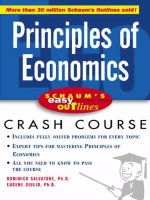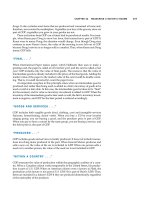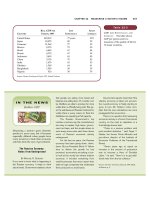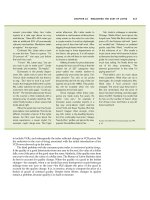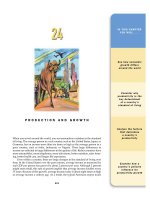Ecological economics
Bạn đang xem bản rút gọn của tài liệu. Xem và tải ngay bản đầy đủ của tài liệu tại đây (4.64 MB, 594 trang )
www.ebook3000.com
This page intentionally left blank
www.ebook3000.com
Ecological Economics
Taking as its starting point the interdependence of human and natural systems this
book provides a comprehensive introduction to the emerging field of ecological economics. The authors, who have written extensively on the economics of sustainability, build on insights from both mainstream economics and ecological sciences. It
assumes no prior knowledge of economics and is well suited for use on interdisciplinary environmental science and management courses.
M i c h a e l C o m m o n is Emeritus Professor at the Graduate School of Environmental
Studies, University of Strathclyde and a member of the editorial board of the journal
Ecological Economics. He is highly respected both for his teaching and as author of
numerous journal and book publications on the economics of the environment since
1973.
S i g r i d S t a g l is a Senior Research Fellow at SPRU, University of Sussex. She is a
member of the editorial board of the journal Environmental Values and is currently
Vice-President of the European Society of Ecological Economics. She was awarded the
first Ph.D in Ecological Economics worldwide.
Companion website: www.cambridge.org/common
www.ebook3000.com
www.ebook3000.com
Common and Stagl have written the definitive text to date for ecological/
environmental economics. It presents the standard theories of neoclassical economics and points the way toward a richer understanding of the relationship
between the human economy and the natural world. The field of economics
is undergoing a revolution that will fundamentally change economic theory
and policy. Central to this revolution is the recognition by economists that
economic behavior cannot be understood outside its social and environmental
context. This text brings environmental economics into the twenty-first century
and will be the standard in the field for years to come.’
j o h n g o w d y , Professor of Economics, Rensselaer Polytechnic Institute, and
former President of the U.S. Society for Ecological Economics
‘Environmental economics has existed as a powerful discipline for nearly
50 years. Ecological economics borrows heavily from it, and overlaps it significantly. But there are differences. Ecological economics perhaps invests more
heavily in understanding ecological science, takes more note of discontinuities
and non-linearities in ecological and economic systems, and pays less attention to notions of economic efficiency and outcomes determined by short-term
human wants. Anyone wanting an explanation and exploration of these differences in a lucid and informative manner will want to own Mick Common and
Sigrid Stagl’s textbook. It is a very fine introduction.’
dav i d p e a r c e , Emeritus Professor of Environmental Economics,
University College London
‘Clear presentations of the reasoning and facts underlying environmental
science and economics, a steady focus on the high hopes of economists and
the earthly fears of ecologists, and inspiring descriptions of how ecological
economists are trying to make sense of life on earth. This is the book we have
been waiting for.’
r i c h a r d b . n o r g a a r d , Professor of Energy and Resources,
University of California, Berkeley, and former President of
the International Society for Ecological Economics
‘This book provides a coherent account of the major environmental challenges to economic and human progress of the twenty first century. It is clear,
direct and easily understandable and conveys a powerful message that we
www.ebook3000.com
ignore the sustainability and ecological aspects of the economy at out peril. I
recommended it highly to all students and scholars of the emerging field.’
n e i l a d g e r , Reader in Environmental Economics,
University of East Anglia.
‘This book satisfies the urgent need for an introductory text on Ecological Economics that is informative but not overly detailed on environmental sciences,
strong on and where necessary critical of economics, and representative in its
coverage of new theory and methods.’
j e r o e n c . j . m . va n d e n b e r g h , Professor of Environmental
Economics, Free University, Amsterdam
‘With this excellent text, Mick Common and Sigrid Stagl have provided an
authoritative introduction to ecological economics. It offers a very clear and
comprehensive review of the concepts, methods and issues on which ecological economics focuses, with a wealth of examples and worked simulations.
Assuming nothing more than the most basic knowledge of mathematics, the
book develops the economic principles relevant to environmental policy; it
also introduces the necessary understanding of the relevant natural scientific
concepts and principles. These economic and scientific methods are then synthesised to analyse current environmental problems and to indicate policy
approaches to their solution. With extensive referencing to the current literature, the book is an excellent basis for the study of ecological economics and
environmental policy.’
j o h n p r o o p s , Professor of Ecological Economics, Keele University, and
former President of the International Society for Ecological Economics
‘Here it is – the book that fills the gap! It offers students a very good introduction to environmental management as the interdisciplinary challenge it is.
It integrates core elements from natural and social sciences into a coherent
text – a rare feature. In doing so it is really enlightening, well structured and
enjoyable to read. Moreover, it is well organized for teaching purposes – even
with a web page attached to it.’
a r i l d va t n , Professor of Environmental Sciences, and
Vice-President of the European Society for Ecological Economics,
Norwegian University of Life Sciences
‘This book offers an innovative and sophisticated approach to teaching ecological economics at the introductory level. For economics students, Common and
Stagl provide a basic understanding of the biophysical foundations and environmental impacts of economic activity. For environmental studies students,
the authors provide a grounded and yet accessible introduction to the concepts
and methods of economics – especially as they relate to the interplay between
economic growth, natural resource depletion, and the achievement of sustainable development. ‘‘Ecological Economics: An Introduction” could and should
www.ebook3000.com
be used in core courses in academic programs aimed at integrating ecology
and economics at the levels of research and praxis.’
r i c h a r d b . h o wa r t h , Professor of Environmental Studies,
Dartmouth College
‘This textbook is a brilliant guide to understanding the global environmental and distributional challenges we are facing. Common and Stagl master a
truly transdisciplinary approach and take a fresh look at the structuring of the
issues, resulting in a textbook that is both committed and balanced and which
offers an alternative perspective to traditional environmental economics introductions. Furthermore, the educational presentation is very carefully prepared
and clear, ideal for beginning students.’
i n g e r ø p k e , Associate Professor, Technical University of Denmark
‘This is the most comprehensive and readable treatment of the complex transdisciplinary field of Ecological Economics to date. It will be a standard reference
for students and practioners for years to come. When it has come to replace
‘‘Samuelson” as the standard textbook for introductory economics courses, we
will know the world is on a path toward sustainability.’
r o b e r t c o s t a n z a , Gund Professor of Ecological Economics and Director,
Gund Institute of Ecological Economics, The University of Vermont, and
former President of the International Society for Ecological Economics
‘How refreshing to see an introductory economics textbook which begins by
stating, ‘‘The pursuit of sustainable development . . . cannot be left to markets –
there is an inescapable role for government”! This new text is the first I’ve seen
which actually begins from the beginning, setting the economy in its environmental context and requiring no prior economics indoctrination (which then
would need to be critiqued and expunged). It explains the rationale behind
modelling and explores basic principles of ecology, thermodynamics and economics before discussing their many complex interrelationships with currency
and style. The sections on policy and governance are sophisticated and comprehensive. This is an introduction to economics for the 21st century, economics
as it must become if the profession – and the global economy itself – are to
survive.’
pa t r i c i a e . p e r k i n s , Associate Professor, York University, Toronto
‘This is the most coherent book introducing ecological economics to date. Other
attempts have proven to be a mishmash to standard economics and alternative
thinking which is often contradictory. Common and Stagl tackle what makes
ecological economics distinct head on and provide the strongest textbook currently on the market. Their coverage of ethical issues upfront is particularly
welcome. The text is clear and well written for the uninitiated.’
p r o f e s s o r c l i v e l . s pa s h , Research Chair in Environmental & Rural
Economics, University of Aberdeen, and President of the
European Society for Ecological Economics
www.ebook3000.com
www.ebook3000.com
Ecological Economics
An Introduction
Mick Common and Sigrid Stagl
www.ebook3000.com
cambridge university press
Cambridge, New York, Melbourne, Madrid, Cape Town, Singapore, São Paulo
Cambridge University Press
The Edinburgh Building, Cambridge cb2 2ru, UK
Published in the United States of America by Cambridge University Press, New York
www.cambridge.org
Information on this title: www.cambridge.org/9780521816458
© Michael Common and Sigrid Stagl 2005
This publication is in copyright. Subject to statutory exception and to the provision of
relevant collective licensing agreements, no reproduction of any part may take place
without the written permission of Cambridge University Press.
First published in print format 2005
isbn-13
isbn-10
978-0-511-12938-4 eBook (EBL)
0-511-12938-6 eBook (EBL)
isbn-13
isbn-10
978-0-521-81645-8 hardback
0-521-81645-9 hardback
isbn-13
isbn-10
978-0-521-01670-4 paperback
0-521-01670-3 paperback
Cambridge University Press has no responsibility for the persistence or accuracy of urls
for external or third-party internet websites referred to in this publication, and does not
guarantee that any content on such websites is, or will remain, accurate or appropriate.
Every effort has been made in preparing this publication to provide accurate and
up-to-date information that is in accord with accepted standards and practice at the time
of publication. Nevertheless, the authors, editors and publisher can make no warranties
that the information contained herein is totally free from error, not least because clinical
standards are constantly changing through research and regulation. The authors, editors
and publisher therefore disclaim all liability for direct or consequential damages
resulting from the use of material contained in this book. Readers are strongly advised
to pay careful attention to information provided by the manufacturer of any drugs or
equipment that they plan to use.
www.ebook3000.com
Contents
List of figures xx
List of tables xxiii
List of boxes xxv
Preface xxvii
Introduction xxix
Chapter 1 An introduction to ecological economics 1
1.1 What is ecological economics? 1
1.2 A brief history of the environment in
economics 3
1.3 Science and ethics 6
1.4 Sustainability and sustainable development 8
1.5 The relationship between ecological and
neoclassical economics 9
1.6 A guided tour 13
Keywords 15
Further Reading 16
Websites 17
Discussion Questions 17
PART I
I N T E RD E P E N D E N T SYST E M S 19
Chapter 2 The environment 21
2.1 Planet earth 22
2.1.1 Systems 22
2.1.2 The lithosphere 23
2.1.3 The hydrosphere 24
2.1.4 The atmosphere 25
2.1.5 The biosphere 25
2.2 Thermodynamics 26
2.2.1 Energy, heat and work 26
2.2.2 First law of thermodynamics 26
2.2.3 Thermodynamic systems classification 29
2.2.4 Second law of thermodynamics 30
2.2.5 Plants as open systems 32
2.2.6 Animals as open systems 34
ix
x
Contents
2.3 Ecosystems 37
2.3.1 Energy and nutrient flows 37
2.3.2 Population dynamics 43
2.3.3 System dynamics 50
2.4 Nutrient cycles 56
2.4.1 The carbon cycle 56
2.5 Evolution 59
2.5.1 Biological evolution 59
2.5.2 Coevolution 61
Summary 62
Keywords 62
Appendix: Doubling times with exponential
growth 63
Further Reading 64
Websites 65
Exercises 65
Chapter 3 Humans in the environment – some history 66
3.1 Human evolution 66
3.1.1 Cultural evolution 67
3.2 The history of human numbers 68
3.3 Hunter-gatherers 69
3.4 The transition to agriculture 72
3.5 The second transition 74
3.5.1 Energy slaves 76
3.5.2 Human numbers in the industrial phase of
human history 77
3.6 Energy and agriculture 78
3.7 The extent of the human impact on the
biosphere 82
Summary 83
Keywords 84
Further Reading 84
Discussion Questions 85
Chapter 4 The economy in the environment – a conceptual
framework 86
4.1 The big picture 86
4.2 Stocks and flows 88
4.3 The economy 90
4.3.1 Consumption 90
4.3.2 Production 90
4.3.3 Investment 91
4.3.4 The productivity of capital accumulation 92
4.3.5 Open and closed economies 93
Contents
4.4 Resource extraction 94
4.4.1 Flow resources 94
4.4.2 Stock resources 95
4.5 Waste insertion 98
4.5.1 Stocks and flows 98
4.5.2 Damage relationships 100
4.6 Implications of the laws of thermodynamics 102
4.6.1 Conservation of mass 102
4.6.2 Entropy 103
4.6.3 Energy flow as an approximate measure of
environmental impact 104
4.7 Recycling 105
4.8 Amenity services 107
4.8.1 Sustainable amenity service
consumption 108
4.8.2 Ex situ consumption of amenity services 109
4.9 Life support services 110
4.10 Interactions 111
4.10.1 A river estuary 111
4.10.2 Resource quality, energy use and waste
generation 112
4.10.3 The enhanced greenhouse effect 113
4.11 Threats to sustainability 114
4.11.1 Resource depletion 114
4.11.2 Waste accumulation 115
4.11.3 Loss of resilience 115
4.11.4 Responses 116
4.11.5 The global perspective 117
Summary 118
Keywords 118
Further Reading 119
Discussion Questions 120
Exercises 120
PART II
ECO N O M I C AC T I V I TY 123
Chapter 5 Economic accounting 125
5.1 Input–output accounting 125
5.1.1 The basic accounts 125
5.1.2 Input–output analysis 128
5.1.3 Accounting for direct and indirect
requirements 129
5.1.4 Input–output accounting and the
environment 130
5.1.5 Input–output structures in history 132
xi
xii
Contents
5.2 National income accounting conventions 136
5.2.1 The basic ideas 136
5.2.2 Gross and net national product 138
5.2.3 Investment is necessarily equal to
saving 139
5.2.4 Accounting for government 140
5.2.5 Foreign trade: national and domestic
national income 142
5.2.6 National income accounting in practice 143
5.3 National income as the measure of economic
performance 144
5.3.1 Income or consumption? 145
5.3.2 Gross or net income? 145
5.3.3 Adjustment for population size and
growth 147
5.3.4 What national income does not include 147
5.3.5 Defensive expenditure 148
5.3.6 The problem of differing relative prices 148
5.4 National income accounting and the
environment 154
5.4.1 Natural resource balance sheets 155
5.4.2 Satellite accounting 156
Summary 158
Keywords 159
Appendix: Input–output algebra 160
Further Reading 163
Websites 164
Discussion Questions 165
Exercises 165
Chapter 6 Economic growth and human well-being 167
6.1 The rich and the poor 167
6.1.1 International comparisons of per capita
national income 167
6.1.2 Many poor, few rich 169
6.1.3 Poverty in the world economy 169
6.2 Why are some countries rich and some
poor? 171
6.3 What drives economic growth? 173
6.3.1 The basic growth model 173
6.3.2 The basic model and the data 182
6.3.3 Efficiency 184
6.3.4 Technological change 185
6.3.5 Endogenous technological progress 186
6.3.6 Explaining economic growth 188
Contents
6.4 The desirability of economic growth 189
6.4.1 Economists and dentists 190
6.4.2 Poverty alleviation 191
6.4.3 Growth and inequality 193
6.4.4 Ecological economics on the desirability of
economic growth 194
6.5 Non-economic indicators of well-being 194
6.5.1 International comparisons 195
6.5.2 Are things getting better? 195
6.5.3 Relationships between GDP per capita and
well-being indicators 196
6.5.4 GDP per capita and happiness 198
6.6 Human needs and desires – what makes people
happy? 200
6.6.1 Measuring and explaining happiness 200
6.6.2 Relationships between income and
happiness 203
6.6.3 Does inequality matter? 205
Summary 205
Keywords 206
Further Reading 206
Discussion Questions 208
Exercises 208
Chapter 7 Economic growth and the environment 210
7.1 The IPAT identity 210
7.1.1 Scenarios for the near future 212
7.1.2 The commodity composition of
GDP – ‘consumption technology’ 216
7.2 Modelling growth and the environment 218
7.2.1 On substitution possibilities 219
7.2.2 Renewable resources 221
7.2.3 Non-renewable resources 228
7.2.4 Summary and overview 234
7.3 Limits to Growth? 236
7.3.1 Growth and the environment in
history 236
7.3.2 The limits to growth 237
7.3.3 Reactions to The limits to growth 244
7.3.4 Beyond the limits 246
7.4 Growth as the solution to environmental
problems? 247
7.4.1 The EKC hypothesis 247
7.4.2 The empirical status of the hypothesis 248
7.4.3 EKC implications 250
xiii
xiv
Contents
7.5
Sustainable development? 254
Summary 257
Keywords 257
Further Reading 257
Websites 259
Discussion questions 259
Exercises 259
Chapter 8 Exchange and markets 261
8.1 Exchange and specialisation 261
8.1.1 Exchange 261
8.1.2 Specialisation in production 262
8.1.3 Money and prices 266
8.2 How markets work 268
8.2.1 Demand and supply functions 268
8.2.2 Non-price influences on demand and
supply 274
8.2.3 Elasticities 275
8.3 Applications of market analysis 282
8.3.1 Price ceilings 282
8.3.2 Price floors 283
8.3.3 Commodity taxation 286
8.4 Lending and borrowing, saving and investing 289
8.4.1 Compounding and discounting 289
8.4.2 Saving and lending 290
8.4.3 Investing and borrowing 292
8.4.4 Savings, investment and the interest
rate 299
Summary 304
Keywords 304
Further Reading 306
Discussion Questions 306
Exercises 306
Chapter 9 Limits to markets 308
9.1 Markets and efficiency 308
9.1.1 The invisible hand – allocative
efficiency 309
9.1.2 What is allocative efficiency? 310
9.1.3 How markets could achieve allocative
efficiency 311
9.1.4 Intertemporal efficiency 316
9.2 Market failure and its correction 320
9.2.1 The conditions needed for markets to
produce allocative efficiency 320
Contents
9.2.2 Market failure is the norm 322
9.2.3 Consumer sovereignty 324
9.2.4 Correcting market failure 325
9.2.5 Multiple sources of market failure 331
9.3 Markets and equity 332
9.3.1 Intratemporal equity 333
9.3.2 Intertemporal efficiency and
distribution 336
9.4 Markets and the environment 337
9.4.1 Property rights 337
9.4.2 Natural resources 339
9.4.3 Waste flows and sinks 349
9.4.4 Amenity and life support services 349
9.5 Markets and sustainability 350
9.5.1 Non-renewable resource depletion and
sustainability 350
9.5.2 The efficient level of waste emissions 352
Summary 354
Keywords 354
Further Reading 356
Discussion Questions 357
Websites 357
Exercises 357
PART III
GOV E R N A N C E 359
Chapter 10 Determining policy objectives 361
10.1 The history of the sustainable development
principle 362
10.1.1 The early days of sustainable
development 362
10.1.2 The ‘Brundtland Report’ – our common
future 362
10.1.3 The United Nations Conference on
Environment and Development
(UNCED) 364
10.1.4 The World Summit on Sustainable
Development (WSSD) 369
10.2 Operationalising the principle 372
10.2.1 What is the principle meant to deliver? 372
10.2.2 Sustainability in neoclassical
economics 374
10.2.3 Sustainability in ecology 376
10.2.4 Sustainability in ecological economics 377
xv
xvi
Contents
10.3 Decision making under imperfect knowledge 379
10.3.1 Project appraisal with imperfect
information 380
10.3.2 Imperfect information and the
environment 385
10.4 The Precautionary Principle and safe minimum
standards 389
10.4.1 The Precautionary Principle 389
10.4.2 Safe minimum standards 392
10.4.3 The Precautionary Principle in the EU 394
10.4.4 The Precautionary Principle in the US 394
10.5 Science and precaution 395
10.6 From policy principles to policy objectives 396
Summary 397
Keywords 397
Further Reading 398
Websites 399
Discussion Questions 400
Exercises 400
Chapter 11 Environmental policy instruments 402
11.1 Choice of environmental policy instruments 403
11.2 Moral suasion 406
11.2.1 Changing preferences 407
11.2.2 Varieties of preferences 407
11.2.3 Innovations in measuring and reporting
economic and environmental
performance 409
11.3 Command-and-control instruments 410
11.3.1 Non-transferable emissions licences 411
11.3.2 Minimum technology requirements 412
11.3.3 Regulation of location of polluting
activities 412
11.4 Creation of property rights 413
11.5 Taxation 415
11.5.1 Taxation for allocative efficiency 415
11.5.2 Taxation for an arbitrary standard 417
11.5.3 Taxation and the goods market 418
11.5.4 Environmental taxes raise revenue 422
11.6 Tradable permits 425
11.7 The least cost theorem 427
11.8 Environmental performance bonds 431
11.9 Interdependence of policy goals 434
Summary 434
Keywords 435
Contents
Further Reading 436
Websites 437
Discussion Questions 437
Exercises 438
Appendix Input-output analysis of carbon
taxation 438
PART IV
T H E I N T E R N AT I O N A L D I M E N S I O N 443
Chapter 12 A world of nation states 445
12.1 The case for international trade 445
12.1.1 The principle of comparative advantage 445
12.1.2 Domestic winners and losers 447
12.1.3 Some qualifications to the principle of
comparative adavantage 449
12.1.4 Trade and the environment – a first
look 451
12.2 Patterns of international trade 452
12.3 International trade and sustainable
development 454
12.3.1 Positive consequences of international
trade 455
12.3.2 Negative consequences of international
trade 460
12.4 Institutions regulating international trade 464
12.4.1 Trade measures – WTO rules 464
12.4.2 Multilateral Environmental Agreements 467
12.5 Towards trade rules for sustainability 468
12.6 Globalisation 471
12.6.1 Role of transnational and multinational
corporations 472
Summary 476
Keywords 476
Further Reading 478
Websites 479
Discussion Questions 480
Exercises 480
Chapter 13 Climate change 482
13.1 The nature and extent of the problem 482
13.1.1 The greenhouse effect 483
13.1.2 The enhanced greenhouse effect 484
xvii
xviii
Contents
13.1.3 The Intergovernmental Panel on Climate
Change 485
13.1.4 The greenhouse gases 486
13.1.5 The enhanced greenhouse effect – impacts
of climate change 493
13.1.6 Responding to the enhanced greenhouse
effect 495
13.2 Why the problem is difficult 498
13.2.1 A global public bad 498
13.2.2 Equity issues 499
13.2.3 Complexity and ignorance 504
13.2.4 Energy use and supply 506
13.3 Mitigation targets and instruments 506
13.3.1 Setting a global target 506
13.3.2 Instrument regimes 508
13.3.3 National sovereignty and mitigation 509
13.4 What is being done about the problem? 510
13.4.1 The United Nations Framework Convention
on Climate Change 510
13.4.2 The Kyoto Protocol 511
13.4.3 What would Kyoto’s impact be? 514
13.4.4 Assessment 516
Summary 517
Keywords 517
Further Reading 518
Websites 519
Discussion Questions 519
Exercises 519
Chapter 14 Biodiversity loss 521
14.1 The biodiversity-loss problem 521
14.1.1 What is biodiversity? 521
14.1.2 How fast is biodiversity being lost? 523
14.1.3 Why is it being lost so fast? 525
14.1.4 Why does biodiversity loss matter? 526
14.2 Why it is a difficult problem 527
14.2.1 Publicness 527
14.2.2 Equity 528
14.2.3 Uncertainty 529
14.3 Conservation policy 529
14.3.1 Ex situ versus in situ conservation 529
14.3.2 Which species to preserve? 530
14.3.3 Habitat preservation and protected
areas 532
www.ebook3000.com
Contents
14.4 The Convention on Biological Diversity 534
14.4.1 Objectives and principles 534
14.4.2 Instruments 535
14.4.3 Assessment 537
Summary 537
Keywords 537
Further Reading 538
Websites 539
Discussion Questions 539
References 540
Index 552
xix
Figures
1.1
1.2
1.3
2.1
2.2
2.3
2.4
2.5
2.6
2.7
2.8
2.9
2.10
2.11
2.12
2.13
2.14
3.1
3.2
4.1
4.2
4.3
4.4
4.5
4.6
4.7
6.1
6.2
6.3
6.4
6.5
6.6
6.7
6.8
6.9
6.10
6.11
6.12
xx
Locating ecological economics
page 2
The economy in the environment
2
Ethical positions of neoclassical and ecological economics
10
Four interacting environmental systems
22
System and environment
23
Living plant as an open system
33
Living animal as an open system
35
A foodweb for a woodland ecosystem
38
A trophic pyramid
38
Energy and nutrient movement in ecosystems
41
Exponential growth
44
Density-dependent growth
46
Some types of population dynamics
49
Forest succession
51
Resilience
53
Another look at resilience
54
The carbon cycle
57
Human population growth
69
The energetics of food production systems
80
Economy–environment interdependence
87
Stock and flow
89
Density-dependent growth
96
Dose–response relationships
101
Recycling
106
Recreational use relationships
109
Environmental service interactions
112
Substitution possibilities with a Cobb–Douglas production function
177
Growth in the basic model
180
Growth and saving
183
Income and population growth
183
Growth and income
183
Growth with technological progress
187
Endogenous technical progress: efficiency and capital
188
Longevity and GDP per capita
197
Infant mortality and GDP per capita
197
Literacy and GDP per capita
198
Happiness and GDP per capita
199
Post-World War II trends in happiness and GDP per capita in the USA
203
Figures
7.1
7.2
7.3
7.4
7.5
7.6
7.7
7.8
7.9
7.10
7.11
7.12
7.13
7.14
7.15
7.16
7.17
7.18
7.19
8.1
8.2
8.3
8.4
8.5
8.6
8.7
8.8
8.9
8.10
8.11
8.12
8.13
8.14
8.15
8.16
9.1
9.2
9.3
9.4
9.5
9.6
9.7
9.8
9.9
Isoquants for three types of substitution situation
Extraction as a constant proportion of remaining stock
Resource stock for declining extraction
Non-renewable resource use with a Leontief production function
Non-renewable resource use with a Leontief production function and
technical progress
Non-renewable resource use with a Cobb–Douglas production
function
Non-renewable resource use with a Cobb–Douglas production function
and technical progress
Exogenous fertility and mortality
Endogenous fertility and mortality
The World Model
Standard run
Increased resources run
The sustainable world run
Hypothesised EKC relationship
Data consistent with the EKC hypothesis
An EKC for carbon dioxide
Emissions for population growth at 2.5 per cent
Emissions for population growth at 5 per cent
Emissions when there is a lower limit to per capita emissions
Gains from production specialisation
Graphical representation of a demand function
Equilibrium price and quantity
Excess supply and demand
Price and quantity adjustment
Elasticity of demand
Elasticity of supply
Short- and long-run market adjustments
Price ceiling
Price floor
Commodity taxation
Lending and saving
Borrowing and investing
Bond market equilibrium
Joint equilibrium in two financial asset markets
Joint equilibria in two economies
The efficiency of market equilibrium
Rates of return and levels of investment
Equalisation of rates of return
The externality problem
The monopoly problem
Two widget market equilibria
Two efficient intertemporal allocations
The market for a non-renewable resource
Efficient fish harvesting
220
230
230
231
232
233
234
238
239
240
241
242
243
247
249
250
251
252
254
264
270
271
272
273
276
279
280
283
284
287
292
297
300
302
303
314
318
319
327
331
334
337
342
345
xxi
xxii
Figures
9.10
9.11
9.12
10.1
11.1
11.2
11.3
11.4
11.5
12.1
12.2
12.3
12.4
12.5
13.1
13.2
13.3
13.4
13.5
13.6
Open access means overfishing
Effects of depletion on open-access harvesting
An intertemporally efficient consumption path
Net Official Development Assistance as percentage of GNI (2003)
The economically efficient level of pollution minimises the sum of
abatement and damage cost
Economically efficient level of emissions abatement
Impact of environmental tax on goods market
Revenue from environment-related taxes as percent of GDP
Least cost theorem
The effects of trade
An import tariff
Trends in world trade in goods (volume) vs. GDP (1990 = 100)
Diving through the EKC
Global diffusion of environmental policy innovation
Physics of the greenhouse effect
The enhanced greenhouse effect
Atmospheric carbon stock for emissions stabilisation 50 years out
Atmospheric carbon stock for emissions stabilisation now
Atmospheric carbon stock for a 50 per cent emissions cut now
Some feedbacks in the enhanced greenhouse effect
346
347
351
365
416
416
419
425
429
447
448
453
458
459
483
484
503
503
504
505
Tables
2.1
2.2
3.1
3.2
5.1
5.2
5.3
5.4
5.5
5.6
5.7
5.8
5.9
5.10
5.11
5.12
5.13
5.14
5.15
5.16
5.17
6.1
6.2
6.3
6.4
6.5
6.6
6.7
6.8
6.9
6.10
6.11
6.12
6.13
6.14
6.15
Net primary productivities for selected biomes
page 39
Annual growth rates and doubling times
45
Energy accounts for food production
79
Human appropriation of net primary productivity
83
Input–output transactions table, $ million
126
Input–output coefficient table
127
Total output requirements per unit delivery to final demand
129
CO2 releases from fossil fuel combustion
133
CO2 intensities and levels for deliveries to final demand,
Australia 1986/7
133
The input–output structure for a hunter-gatherer economy
134
The input–output structure for an agricultural phase economy
135
The input–output structure for an industrial economy
136
Summary national income accounting for the United Kingdom 2001
143
A numerical example for measuring the change in GDP
149
Nominal and real GDP: constant relative prices
150
Nominal and real GDP: changing relative prices
150
Measuring real GDP when quantities go down as well as up
151
Departures from purchasing power parity according to Big Mac prices
153
Calculating GDP in PPP US$
154
Opening and closing natural resource balance sheets
156
Alternative estimates of the depreciation of Australia’s non-renewable
resources
158
International comparisons of per capita GDP
168
Current and projected population sizes
169
People living in poverty
170
Implications of 100 years’ growth at different rates
172
Implied growth rates over 500 years
173
Income and capital per capita in the basic model
180
Income per capita after 100 years
181
Economic growth and efficiency in input use
185
Income and capital per capita with technological progress
186
Endogenous technological progress
187
Recent growth rates and per capita GDP projections
193
The implications of recent growth rates for global income inequalities
194
Some basic indicators of well-being
195
Recent trends in well-being indicators
196
GDP compared with other indicators
196
xxiii
